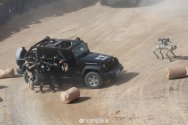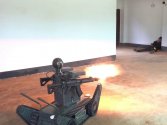You are using an out of date browser. It may not display this or other websites correctly.
You should upgrade or use an alternative browser.
You should upgrade or use an alternative browser.
Unmanned Combat Ground Vehicle
- Thread starter rhino123
- Start date
video from their recent anti-terrorism exercise with Vietnam. Really showing off the unmanned technology here.
All these robodogs materials seem to focus on single dog scouts for small formations.
What seems like an even better use is mass scale robodog usage all over the front, perhaps even airdropping them just behind the front.
Sure, they lack autonomy to be meaningfully lethal on their own, but the mere presence of massive number of robodogs with guns should trigger enemy fire, thus showing their location. In concert with prepped observation and fire support units, such robodog formations could be quite problematic for the opponent.
Even if the commercial price of 1600 USD+gun is upheld, literally tens of thousands could be expended at no great cost.
What seems like an even better use is mass scale robodog usage all over the front, perhaps even airdropping them just behind the front.
Sure, they lack autonomy to be meaningfully lethal on their own, but the mere presence of massive number of robodogs with guns should trigger enemy fire, thus showing their location. In concert with prepped observation and fire support units, such robodog formations could be quite problematic for the opponent.
Even if the commercial price of 1600 USD+gun is upheld, literally tens of thousands could be expended at no great cost.
All these robodogs materials seem to focus on single dog scouts for small formations.
What seems like an even better use is mass scale robodog usage all over the front, perhaps even airdropping them just behind the front.
Sure, they lack autonomy to be meaningfully lethal on their own, but the mere presence of massive number of robodogs with guns should trigger enemy fire, thus showing their location. In concert with prepped observation and fire support units, such robodog formations could be quite problematic for the opponent.
Even if the commercial price of 1600 USD+gun is upheld, literally tens of thousands could be expended at no great cost.
My gut tells me that airborne drones are more effective than weaponised robodogs, so you'd be looking at much larger numbers of airborne drones versus robodogs.
Ground-based units can't see very far, especially if there are obstacles. Plus they are pretty slow.
In comparison, an airborne drone flying at 100m has a visual horizon of 35km, and fast FPV drones are like $500. It's worth expending such a drone on literally any sort of military target. Small, fast FPV drones are difficult to shoot down.
I think any notional ground battlefield (in Taiwan or South Korea for example) involving the Chinese Army will be like the description below.
You are not considering a lot of real world factors.
Explosions are not directional. Well, they can be if you use shaped charges, but that’s not applicable in this scenario so can be discounted.
Having FPVs go boom right in front of your assault line is a great way to disrupt your advance. Troops do advance under general artillery barrage, but that artillery barrage needs to stop when your troops get close to contact, which has always and remains the main limitations with explosive suppression.
The suppressive effect of a LMG are much more directional and precise and can be used to suppress enemies without impacting on your own troops advance.
The other main problem with FPVs is pilots and jamming.
Just how many pivots does your FPV spam require? Also, in the future, FPVs are likely to become increasingly ineffective as jamming gets more develop and proliferated.
The way to deal with jamming is with bigger and more powerful antennas, better signal processing etc, all of which needs more power and space and makes the drone more expensive. Fine for big durable drones like this, less fine for tiny consumable drones like FPVs.
The fundamental solution to those problems is to use technology to take the pilot out of the equation and use fully autonomous suicide swarm drones. China basically has this tech near operational deployment stage, if it’s not there already just Google Chinese drones autonomously navigating forests for example.
Thus the biggest issue with your argument isn’t in pointing out the different strengths and weaknesses of the two types of drones, but in making the completely unnecessary and unreasonable assumption that China needs to pick one over the other.
In reality, the PLA will make extensive use of all drone types we know of and many more we don’t. You will have waves of autonomous mini suicide drones combing enemy positions for troops and weapons to explode. You will have swarms of armed dogbots and flying drones shooting every enemy they come across. You will have high end UCAVs and UAVs providing air strikes and live aero feeds to assets on the ground. You will have drone motherships coming in dropping off fresh suicide drones. You will have cargo drones coming in with weapons and supplies. You will have medivac drones hauling the wounded away. You will likely have mobile drone docks for drones to land to automatically rearm and swop out batteries and immediately head back into the fray without much downtime. You may even have drones airdropping commandos.
It’s funny looking at people taking Ukraine as the ultimate manifestation of drone warfare when they are barely scratching the surface of what is to come since they are literally cobbling their drone war together using commercial toys. This is why Chinese commentators are always so dismissive of Ukraine. It’s just two zero-base powers stumbling around figuring out their first steps. The PLA is much further down this development path and has a lot more capable military grade toys.
How far away do you think autonomy is? Once that happens then even single units can go on missions, behind enemy lines.All these robodogs materials seem to focus on single dog scouts for small formations.
What seems like an even better use is mass scale robodog usage all over the front, perhaps even airdropping them just behind the front.
Sure, they lack autonomy to be meaningfully lethal on their own, but the mere presence of massive number of robodogs with guns should trigger enemy fire, thus showing their location. In concert with prepped observation and fire support units, such robodog formations could be quite problematic for the opponent.
Even if the commercial price of 1600 USD+gun is upheld, literally tens of thousands could be expended at no great cost.













